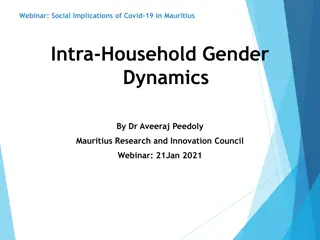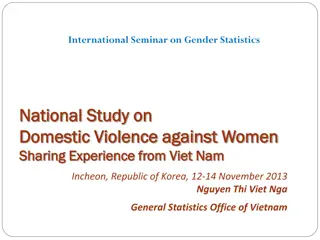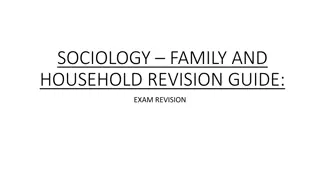The Future of Domestic Work in the GCC - Research Insights
Research commissioned by the Secretariat of the Abu Dhabi Dialogue explores the significance of the domestic work sector in the GCC economy, highlighting key trends, challenges, and implications for human resource management. With a focus on the growing demand for domestic workers in the region, the study delves into workforce composition, employer-worker matching, and the impact of global transformations on the domestic work sector.
Download Presentation

Please find below an Image/Link to download the presentation.
The content on the website is provided AS IS for your information and personal use only. It may not be sold, licensed, or shared on other websites without obtaining consent from the author. Download presentation by click this link. If you encounter any issues during the download, it is possible that the publisher has removed the file from their server.
E N D
Presentation Transcript
The Future of Domestic Work in the GCC The Future of Domestic Work in the GCC Marie Jose Tayah (IDWF) & Hadi Assaf (Consultant) Research commissioned by the Secretariat of the Abu Dhabi Dialogue among the Asian labour-sending and receiving countries Senior Officials Meeting in Colombo, Sri Lanka on 8-9 May 2018
Global debate: Future of work, future of domestic work Caring jobs require social interaction, empathy and judgment and therefore cannot be automated (World Bank 2018). Demand for occupations like childcare, early-childhood education, cleaning, cooking, and gardening will grow, creating 50 million to 90 million jobs globally (McKinsey Global Institute 2017). Growing female labour force participation rates plus Demographic transformations: longer life expectancy, lower fertility and a growing old age dependency ratio. An ever expanding deficit in health care workers. Deficit was 7.2 million in 2013. Expected to reach 12.9 million by 2035 (WHO 2013) Growing share of people in need of paid (professional and non-professional) long- term care. Care site-shiftinghas lead to task-shifting: specialized nurses assume the role of doctors. Domestic workers assume the role of unregulated nurses. Out-patient care in private homes, especially in the case of long-term and post- operative care.
Research questions and scope Questions: Where is the GCC from these global transformations? What are implications for the management of human resources (DW)? Research aims to: Examine the size and composition of the DW sector at national and GCC levels. Examine the demand in the DW sector: determinants and structure. Analyze the current state of affairs in employer-domestic worker matching (examples from Abu Dhabi and Dubai in the pre Tadbeer Center phase) Reflect on human resource decisions concerning the domestic work sector in the countries of the GCC.
A. Domestic work is a significant sector of the GCC economy and growing
3.77 million domestic workers In 2016, GCC countries hosted around 3.77 million domestic workers, 1.65 million of whom (or 44 per cent) were women. Of the remaining 1.54 million men domestic workers, 73 percent were employed, mainly as drivers, in Saudi Arabia. (Figures in thousands) 2,303K 1,544 759 678K 346 332 306K Total 195K 219 174K 111K 148 108 87 66 67 48 44 Female Male Female Male Female Male Female Male Female Male Female Male Bahrain Kuwait Oman Qatar Saudi Arabia UAE
Domestic workers as a percentage of migrant workers Women domestic workers as % of non-national female employment Men domestic workers as % of non-national male employment 82.8 Dubai 1.2 76.7 67.2 65.5 Qatar 3.9 61.9 Bahrain 4.9 45.9 33.4 Oman 10.9 Abu Dhabi 15.3 Saudi Arabia 15.6 Abu Dhabi Saudi Arabia Kuwait Bahrain Oman Qatar Dubai Kuwait 18.0
35,970 new domestic workers every year Annual growth rate in the number of domestic workers is 8.7 per cent (or 35,970 domestic workers). If we exclude Saudi Arabia, the annual growth rate in the number of domestic workers is 8.2 per cent (or 11,400 domestic workers). 159K Annual increase 14.7K 13.7K 13.2K 11.1K 11.3 Annual growth % 13.3 2.2 10.8 8.8 4.2K 6.0 UAE Oman Saudi Kuwait Bahrain Qatar 2008-2016 2007-2016 2007-2017 2012-2017 2005-2017 2006-2016
B. Explaining the demand for domestic workers: Two trends.
Two explanations Demand among nationals Demand among expatriates Increasing households due to higher FLFPRs combined with growing child and elderly care needs in national contexts where care is traditionally the responsibility of women in the family and where intergenerational households are being replaced by nuclear households. A growing population of dual wage-earning expatriate families with child care needs and a demand for professional housekeepers who require little supervision. care pressures on national
B1. Explaining the demand for domestic workers: National Households
Familializing and de-familializing child and elderly care policies Familializing Familializing care (providing incentives for care by the family) care policies policies Time Time rights rights: : such as parental leave or care leave. Part Part- -time time work work Long Long leaves leaves (negative influence on reintegration into the labour market). Cash Cash benefits benefits: survivor s pension or free membership of the spouse s health insurance plan; parental leave benefits or care leave benefits. De De- -familializing familializing care (de-incentivizing care by the family) care policies policies Day Day care facilities (high supply and low costs), and a high quality of care provision. care: : long and flexible opening hours, easy access to care Residential Residential or or partially partially residential residential care care facilities facilities for for the the elderly elderly. . Dense Dense network network of of ambulatory ambulatory care care services services for for the the elderly elderly: : Source: Adapted from Leitner 2003.
GCC: Familializing or de-familializing? The majority of child care policies are familializing, in the form of time rights, part- time work and long leaves. Saudi Saudi population population ( (65 2016 2016 / / Elderly Elderly Survey 65 Years Years and Survey 2016 2016 - - Saudi and over) over) by Saudi Arabia by age age group Arabia General General Authority group and Authority for and those those who who help for Statistics Statistics help them them in in their their daily daily needs, needs, Age Groups Age Groups Assistance Provider Assistance Provider Nurse Nurse Friends Friends\ \Other relatives relatives Other Family member Family member Total Total De-familializing child care policies are now effective in the UAE, Saudi Arabia and Kuwait (in the form of workplace cr ches) among public sector employees. 65 65 69 69 2,094 1,776 31,660 35,530 70 70 74 74 1,984 1,318 38,415 41,717 75 75 79 79 4,859 618 29,588 35,065 80+ 80+ 10,328 2,484 62,849 75,661 Total Total 19,265 6,196 162,512 187,973 Dense network of ambulatory elderly care services in Bahrain, Oman, Saudi Arabia and the UAE, but only where no relatives exist.
Female labour force participation rates among nationals are growing Abu Dhabi Saudi Arabia 18.3 34.9 33.8 31.6 29.9 28.5 12.9 12.6 10.1 10.1 17.6 2008 2011 2013 2014 2015 2016 1990 2000 2006 2010 2016 Kuwait Bahrain 39.3 30.4 37.6 29.0 32.0 26.2 20.0 14.0 2003 2008 2014 2015 1991 2001 2010 2017 Qatar Oman 36.9 36.1 35.0 34.7 34.6 25.3 31.5 27.4 18.7 6.7 2001 2011 2012 2013 2014 2015 2016 1993 2003 2010
High and growing life expectancy and high and declining fertility Fertility Rate 5 SSA 4.5 Africa Oman 4 Abu Dhabi Arab region Kuwait 3.5 Dubai Saudi Arabia 3 Qatar North Africa Bahrain World 2.5 Western Asia Southern Asia North America LAC Middle-income countries 2 Europe Asia SEA 1.5 High-Income Upper-middle-income East Asia 1 60 62 64 66 68 70 72 74 76 78 80 82 Life Expectancy
Life expectancy and fertility by country Saudi nationals Bahraini nationals Fertility rate Life expectancy Fertility rate Life expectancy 6.0 77 Life Expectancy Fertility Life Expectancy Fertility 3.4 78 5.5 3.2 75 5.5 77 75 3.2 77 5.0 76 3.0 73 4.5 75 2.8 4.0 71 74 2.7 2.6 69 73 3.5 69 2.9 2.4 73 72 3.0 2.2 67 71 2.5 2.0 70 2.0 65 2000 2003 2007 2010 2012 2016 1990 2000 2006 2007 2008 2009 2010 2011 2012 2013 2014 2015 2016 Qatari nationals Omani nationals 4.5 82 6.5 6.0 4.2 Life Expectancy Fertility 79 Life Expectancy Fertility 6.0 81 77 81 4.0 77 5.5 80 5.0 75 3.5 79 4.5 73 3.0 4.0 71 4.0 78 3.0 71 3.5 77 69 3.0 2.5 76 76 67 2.5 2.0 75 2.0 65 2005 2010 2011 2012 2013 2014 2015 2016 1995 2000 2005 2010 2011 2012 2013 2014 2015 2016
Life expectancy and fertility by country (contd) Abu Dhabi nationals Dubai nationals Life Expectancy Fertility Fertility rate Life expectancy Fertility rate Life expectancy Life Expectancy Fertility 3.8 4.0 80 4.0 82 3.7 3.5 80 78 3.5 3.5 80 3.2 78 76 3.0 3.0 76 74 76 77 77 74 2.5 2.5 72 72 2.0 70 2.0 70 2010 2011 2012 2013 2014 2015 2016 2011 2012 2013 2014 2015 2016 Kuwaiti nationals Life Expectancy Fertility 5.5 82 5.3 5.0 80 79 4.5 78 4.0 3.6 76 3.5 74 74 3.0 72 2.5 2.0 70 1995 2000 2005 2011 2012 2013 2015 2016
Children constitute 34 per cent of the total national population Despite declining over time, the share of children among national population is high. Children (ages 0-14) those who are in need of quality care constitute 34 per cent of the total national population.
B2. Explaining the demand for domestic workers: Expatriates Households
Total population has increased by 51 per cent (4.2 per cent annually) Over the past decade, the total population of the GCC countries has increased by 51 per cent (by 18 million) or by 4.2 per cent annually. On average, the national GCC population increased by 2.7 per cent annually.
Population growth is driven by expatriates Population growth is driven by expatriates of whom a significant number are dual wage earners who need and can afford the services of domestic workers to perform child care, tutoring, housekeeping and cooking functions. Average monthly household income in GCC countries (USD) Nationals 24,235 19,671 11,148 4,728 Saudi Arabia 3,629 Oman 3,049 Non-Nationals Total 11,430 Year 2013 2014 2013 2015 2013 2012 Qatar Dubai Kuwait Bahrain 6,707 7,656 3,126 3,838 .. 6,448 4,421 2,859 .. 1,693 ..
C. Current state of affairs in employer-domestic worker matching: Examples from AD and Dubai (pre- Tadbeer phase)
Scope Map how the market is structured in the UAE; Examine modalities of employer-domestic workers matching among placement agencies in the UAE; and, Assess the demand for skilled workers among employers and the need for skills training among domestic workers in the UAE.
Methodology Interviews with 10 Tadbeer operators. Interviews with 82 domestic workers. 2 FGDs with DWs. 2 FGDs with employers.
How is the demand for domestic workers structured? Despite the diversity of Tadbeer operators and their experience, there is general consensus among them that the demand is highest for housemaids (who are also nannies and cooks), followed by nannies and then cooks. Nannies are the highest paid category (USD 500) among the three, followed by uncertified cooks (USD 400) and housemaids (USD 320-408). The demand was less significant for the remaining categories (tutors, private nurses, gardeners, watchmen, family drivers, housekeepers, personal assistants and farmers) because employers generally recruit them directly without the intermediation of labour recruiters. The latter are higher-skilled occupations and, in the absence of NOS, certification and proper matching processes, employers prefer recruitment through informal networks where they can verify candidates references (in the case of informal education) and credentials (in the case of formal education).
Matching modalities Example of video content circulated by placement agencies via social media applications Placement agencies circulate videos via social media. These are short videos (under two minutes) during which a recruiter asks a domestic worker the following questions (verbatim): Your name Age Are you married? Do you have children? What is your employment history? (Usually referring to countries she has worked in as domestic worker before arriving in the UAE). Can you clean? Can you cook? What meals can you cook? Can you hold a baby? Can you prepare deserts? Which? Using social media platforms like WhatsApp or Facebook. Online lists of matching criteria mixing identity and occupational identifiers which employers can use to shortlist potential candidates. Interviews with the workers (usually unidirectional, with the employer interviewing the worker). Direct selection by labour recruiters without employer input or based on earlier intake with employers. Agency Agency criteria These are the matching criteria used by one of the placement agencies, now a TSC. criteria that that employers employers are are invited invited to to select select in in order order to to shortlist shortlist workers workers for for interviews interviews Please tell us about yourself. You have: A preference for a Filipino maid A requirement for a Muslim maid A cat A dog Fondness for western food A preference for an Ethiopian maid A special needs child Fondness for Arabic food Fondness for Asian food An infant (new-born to 2 years) A child between 2 and 16 years An elderly parent Source: Maids.cc Tadbeer Service Center.
Matching modalities (contd) Composite index of labour matching dimensions among recruiters Personal/physic al attributes - Religion. - Age: According to recruiters, 40-50 is the most desirable age category because workers have fewer family responsibilities and are less distracted by personal issues. Second best performing age category, according to recruiters, is women aged 30-40 because they possess the level of maturity required for the job. - Height and weight are determining factors in the case of elderly caregivers or caregivers for people with disabilities. Experience - Ability to cook a certain style of food (Western, Asian, Mediterranean ). - Caring for special needs child (especially violent autism). - Pet minding skills. - Post-natal care skills, especially in the case of twins. - Caring for the elderly. Family status - Marital status (a recent divorce or separation are viewed as distracting and therefore divorcees are avoided by labour recruiters). - Mothers with children below the age of 7 are also avoided by recruiters. They are thought to affect worker retention and focus on the job. - Mothers with children are sought-after for childcare arrangements because of their experience in raising children of different age categories. - Nationality. Three categories of shortcuts in the matching process; personal and physical attributes, experience, and family status.
Matching modalities (contd) Stereotypes and assumptions by: (a) employers about work performed by women from different nationalities; (b) workers about employers from different nationalities and religious backgrounds; (c) workers about other workers from different nationalities; (d) labour recruiters about employers from different nationalities; and, (e) labour recruiters about domestic workers from different nationalities.
Hidden assumptions Western Expats: Class guilt and cleaning after oneself ideal Arab expats: Compensating for the need to outsource care with close supervision Nationals and Arab expatriates are micro- managers. They monitor us closely. We prefer to work with Western expats. They trust us with the work and let us manage our time (Focus group with domestic workers in Dubai; also confirmed in Abu Dhabi). I personally like to do things myself; I also do not like the idea of a person depending on me what happens when my children grow older and I have to terminate her contract (American employer in Abu Dhabi). Parents do not want to admit to hiring a nanny because it is their job and do not want to be judged by relatives for delegating their caregiving responsibilities (Labour recruiter in Dubai). I am not comfortable telling her (the domestic worker) what to do, so I just let her be (German employer in Abu Dhabi).
Skills and prior learning assessment modalities Timing and type of agency skills assessment and skilling interventions Timing of intervention Pre-departure checks Type of intervention This is achieved via interviews in the country of origin and through the verification of their Facebook chatter. Previously, labour recruiters set up trainingcamps to train domestic workers pre-departure. Training camps were an opportunity to weed out workers who did not demonstrate the skills and competence required for the job before deployment. These programmes have now been replaced by national programmes. On-arrival, pre-placement trainings Only two of the labour recruiters interviewed provided trainings in UAE model villas before placing workers. Training is limited to housekeeping and cooking. On-arrival trial-and-error placement Most recruiters consider trial periods and, in the words of two labour recruiters, endless worker replacement possibilities, a solution to poor matching. On-the-job trainings One labour recruiter is providing custom-made trainings in employers household (for an employer-paid fee). The Training and Management package lasts 12 months and is divided into 12 weekly testing modules, offering three hours of in-house training each month.
Demand for Skills: Employers A demand for vocational and transversal skills but also for skills that reduce the transaction cost of recruitment and the emotional cost of parting with the worker. Examples (transaction cost reducing skills): employers look for domestic workers with experience working with children of different age categories so as not to hire a new work when the children s developmental needs change; employers seek workers who can adjust their time management and upgrade their vocational skills when they move to larger homes with fancier finishing, furniture and household appliances, usually entertaining at a higher frequency.
Demand for skills: Workers A need for skills relating to employment arrangements, self- preservation skills and vocational skills. In relation to employment arrangements (on-demand arrangement): (a) adjust to different households of different sizes, with different dynamics and work- sharing arrangements each time (sometime during the same day); (b) manage relationships with multiple employers of different nationalities and distinct household cultures; (c) manage their time better (they do not have the luxury of parsing out the tasks over a full day or week); (d) manage stress and work pressures to avoid burnout; and, (e) develop strategies to deal with repetitive movements which can cause muscle strain injuries.
Recognizing workers employment history and providing opportunities for mobility within the sector Domestic workers in the UAE gain new skills on the job that allow them to move: From: low-wage, nanny only, housekeeper only and cook only, closely-supervised live-in employment arrangements in large households To: higher-waged housekeeping or nanny-only (or both) live-out arrangements where they are rather autonomous in carrying out their tasks. These skills are not formally recognized under the current system. The transition depends on the worker s social network among employers, communication skills and individual bargaining capacity. Workers unable to transition through employer networks, sign up for on-demand cleaning employment arrangements hoping to find, in the process, a suitable employer who will provide them with the higher wage, lower workload, more autonomy, live out employment arrangement.
The way forward reflecting on what the longer-term demand in the sector means for a labour admission system for domestic workers; developing national benchmarks or occupational standards that capture the segmentation within the sector; developing, assessing, and recognizing workers skills against a national benchmark to better match employer expectations with worker qualifications and to improve the quality of the services delivered to employers, especially those related to child, elderly and post-operative care where developmental, safety and hygiene protocols are paramount; promoting workers mobility within the sector (from lower to higher complexity tasks) in accordance with these same benchmarks; and, progressively moving away from the nationality-based wage differentials to a waging system modelled after the benchmarks.
Suggestions for the way forward: Linking wage increases to complexity in the sector and tying labour admission to skill certification or to recognition of prior learning (RPL) systems. Developing regional competence standards (RCS) to recognize the regional mobility of domestic workers and to transition from the logic of facilitating market access based on nationality to the logic of harmonized, transparent and efficient labour matching. Tying RCS to regional skills passports for domestic workers to recognize the experience of workers who are mobile within the GCC and progressively promote the recognition of these passports for returning domestic workers (in the GCC-Asia or GCC-Africa migration corridors). Expanding the discussion on RCS (and corresponding wage levels) to organizations representing relevant interest groups (e.g., groups and government agencies representing the interests of families, the elderly, women, migrant workers, children, and people with disability) to garner support for these standards and to revise and adjust them in light of local economic factors and the needs of migrant domestic workers and their families.
EXAMPLE: Job classification of domestic workers and carers in Italy (CBA 2013) Domestic workers with no experience Level A Assistants to self-sufficient individuals Level B Individual assistants to non-self-sufficient individuals, unskilled Level C Individual assistants to non-self-sufficient individuals, trained and skilled (highest earning category) Level D
EXAMPLE: Job classification of private household personnel in Argentina (CBA 2013) Supervisors: personnel hired to coordinate and supervise the tasks of two or more domestic workers.* Cooks: personnel hired exclusively to cook.** Caseros/as: live-in personnel performing tasks for the preservation of the dwelling Caregivers: personnel providing non-therapeutic assistance and care to children, elders, the sick and people with disability. *** Personnel for general tasks: personnel hired to perform a number of household tasks such as cleaning, washing, ironing, maintenance, preparing and cooking meals.
EXAMPLE: Job classification of domestic workers in Hong Kong SAR, China 10 USD/hour. General cleaning 14 - 16.6 USD/hour Special / intensive cleaning 2,250 USD/month Post-natal care
EXAMPLE: Regional Model Competency Standards for Domestic Work in ASEAN (ILO 2014) A1. Communicate effectively in a domestic work environment; A2. Work in a socially and culturally diverse workplace; A3. Maintain health, safety and security in a domestic work environment; A4. Plan, organize and manage own work; A5. Undertake calculations relevant to domestic work; and A6. Use a language other than the local language to communicate in a domestic work setting. Core competencies B1. Apply basic cleaning principles to perform cleaning tasks; B2. Clean and maintain bedrooms and living areas; B3. Clean and maintain bathrooms and toilet facilities; B4. Wash cloths, linens and fabrics; and B5. Iron and store laundered items. Domestic cleaning and basic housekeeping C1. Clean and maintain food preparation, storage and service areas; C2. Follow basic food safety practices; C3. Organize and prepare basic food in a domestic setting; and C4. Serve food and beverages. Cooking and food handling D1. Work effectively with families to provide care and support for infants and children; D2. Provide care and support for the infants and/or toddlers in a household; and D3. Provide care and support for children in a household. Care for infants and children Care for elderly people E1. Provide support to elderly people to meet personal care needs; and E2. Assist client with medication. F1. Provide care for pets in a household; and F2. Provide care for plants in a household. Care for household pets and plants

















































